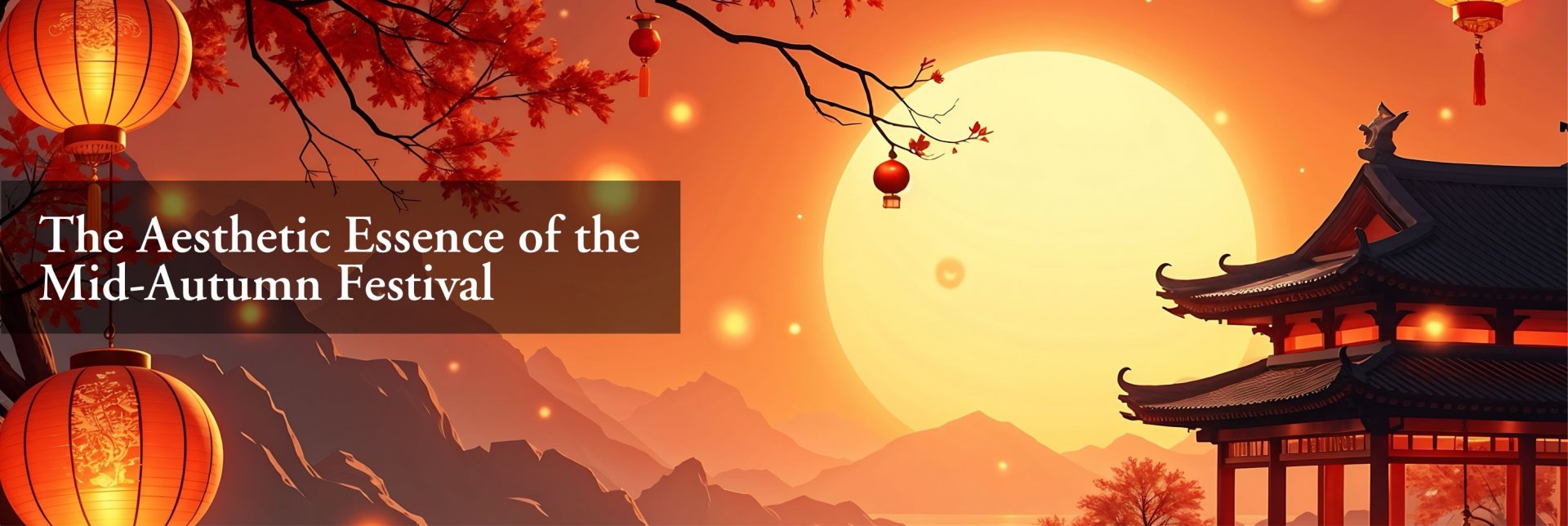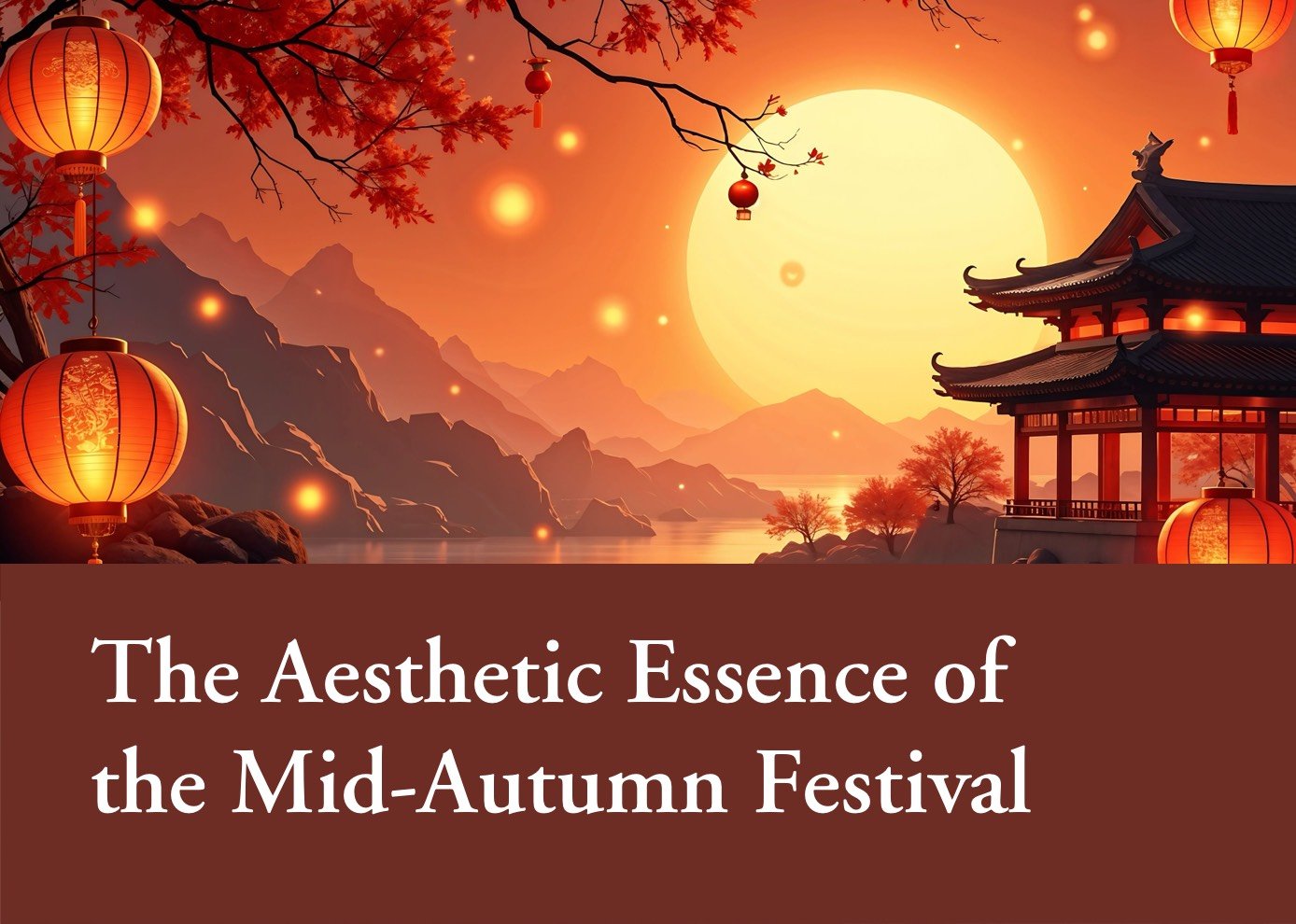The Aesthetic Essence of the Mid-Autumn Festival
Amongst the myriads of festivals celebrated in China, the Mid-Autumn Festival stands out for its profound aesthetic significance. The Chinese have long cherished the autumn moon, a sentiment echoed in ancient texts. The Rites of Zhou states, “Mid-Autumn welcomes the cold qi (氣),”suggesting that the term "Mid-Autumn" predates the modern celebration of the festival on the 15th day of the 8th lunar month, referring to Zhongqiu (仲秋), or the autumnal equinox (Qiu Fen 秋分), in the context of the 24 solar terms. Here, "fen" (分) signifies half, representing the midpoint of the three-month autumn season. The autumnal equinox is dedicated to the Moon, while the spring equinox honors the Sun. During the day, people would beat earthen drums to welcome the heat and perform the poems of "Bin" (豳), while at night, they similarly welcomed the cold qi with Moon worship, accompanied by the same rhythmic drumming and poetic melodies.
Some scholars argue that the Mid-Autumn Festival evolved from the autumnal equinox rituals. The festival, observed on the day of the full Moon, diverges from the equinox, yet it retains the moon's artistic allure. Ouyang Zhan's Preface to the Poem of Wanyue (翫月詩序) offers insights from a poetic perspective. He notes, "Fifteen signifies a full moon in the middle of August. According to the way of heaven, the cold and the heat are balanced; on this day, the Moon is perfectly round." Thus, it is particularly poetic that, in August, during the full Moon, the temperature finds equilibrium. The transition from autumnal equinox Moon worship to the Mid-Autumn Festival is rooted in the Moon's enchanting appeal.
The Complete Poems of the Tang Dynasty contains an impressive 11,950 instances of characters related to the moon, alongside 81 poems specifically entitled "Mid-Autumn." This abundance underscores the profound affection that Tang poets held for the moon. Their heartfelt emotions were intricately woven into their verses, reflecting the sentiments expressed by Ouyang Zhan in his Preface to the Poem of Wanyue.
The allure of the full moon is further enhanced by captivating mythological tales. The story of Chang'e flying to the moon, believed to have circulated during the Warring States Period, recounts how she ascended after consuming the elixir of the Queen Mother of the West. Ancient artifacts, such as a T-shaped silk painting from Mawangdui, depict a crescent moon with a toad and a woman, likely Chang'e, ascending towards it. The worship of the Queen Mother of the West thrived during the Han Dynasty, illustrated by a tomb brick painting where she is flanked by the Jade Rabbits, with a toad dancing in front of her. I wonder if the scene in the painting depicts the Queen Mother of the West in Mount Kunlun or in the Moon Palace? As Chang'e ascends to the moon, she truly is the first mythological figure to "land" on the moon—a precursor to the later Chang'e lunar landers.
In a later embodiment of this lunar fascination, Tang Xuanzong唐玄宗, the Emperor of the Tang Dynasty, purportedly ascended to the Moon Palace on the night of the Mid-Autumn Festival, making him the second figure to set foot on the moon. He confirmed the "Mansion of Guanghan Qingxu" (廣寒清虛之府) as a landmark and composed the enchanting dance music "Dance of Colorful Clothes and Feather Clothes" (霓裳羽衣舞曲), blending myth and Taoist lore through rich imagination.
During the Tang Dynasty, poets, officials, and aristocrats alike found inspiration in the moonlit nights of the Mid-Autumn Festival. The soft, lingering moonlight captivated their hearts. It is said that during Emperor Xuanzong's reign, on the night of the festival, Su Ting 蘇頲and Li Ai李乂, while on duty in the palace, hosted a banquet with fellow officials to compose poetry and admire the moon. With a clear sky and a resplendent full moon overhead, Su Ting remarked, "The moonlight is lovely; why use lamps and candles?" He encouraged the removal of lights to restore the moon's natural brilliance. This illustrates the artistic sensibilities and keen aesthetic tastes of the Tang people, who reveled in the romantic atmosphere of a serene, moonlit night, embracing both love and longing for its beauty.
Sikong Tu (司空圖) captured this sentiment in his poem "Mid-Autumn Festival": “I chant amid the autumn scenery; everything feels leisurely. If there is no moon tonight, the year will be spent in vain.”His words express the deep aesthetic yearnings of the Tang people. Records from the Dongjing Menghua Lu (東京夢華錄), Mengliang Lu (夢粱錄), and Zuiweng Tanlu (醉翁談錄) depict the robust celebrations of the Mid-Autumn Festival during the Song Dynasty, adorned with colorful lanterns and vibrant festivities. Wine was integral to the celebrations, with stores brewing new wine in anticipation of eager patrons. By noon, supplies would often run dry. The autumn crabs, considered a culinary delight, paired perfectly with the wine. Season's bounty of pomegranates, pears, jujubes, chestnuts, grapes, and oranges—each fruit bursts with color and flavor.
The Song Dynasty's Mid-Autumn Festival was a lively occasion, characterized by family reunions and evening banquets. Many gatherings took place in restaurants, filled with music, laughter, and animated conversations under the moonlit sky. The tradition of Wan Yue (玩月), which involves decorating fruits, wine, and food to celebrate the festival, persisted. Young people dressed in their finest attire, shops remained open late, and civilians gathered to revel in the festivities. According to Tian Rucheng (田汝成), the Ming Dynasty also embraced the custom of exchanging mooncakes as tokens of family reunion during the Mid-Autumn Festival. In Hangzhou, citizens celebrated by taking boat rides across West Lake, often singing and enjoying the bright moonlight, creating an atmosphere that mirrored the vibrancy of daytime.
The Mid-Autumn Festival is indeed a divine gift. Beneath the vast blue sky, the harvest season offers a bounty of crops—watermelons, peaches, persimmons, hawthorns, pomelo, apples, and water chestnuts—each embodying the sweet essence of autumn. In the Five-Element system, sweetness corresponds to the earth element, situated in the southwest, harmonizing with the transition from summer to autumn. The earth, as a nurturing mother, creates the joyous conditions for the Mid-Autumn Festival. Autumn, aligned with the west and the metal element, is represented by the color white, echoing the Dui Hexagram (兌卦) a symbol of happiness. The concept of "Dui" (兌) embodies the joy of life, making the Mid-Autumn Festival a gem of this delightful season.
As an ancient festival, the Mid-Autumn Festival represents a cultural legacy woven together by generations over millennia. The Chinese have held a deep affection for the Moon since antiquity, often expressing their emotions through its serene presence. The Moon serves as a conduit for shared feelings; when gazing upon its gentle light, one cannot help but feel a connection with others who are also admiring it. This sentiment is beautifully captured in the lines from Cao Song’s (曹松) poem Mid-Autumn Festival to the Moon: “The Moon shines at the beginning and end of the sky, the moon has never selfishly illuminated just one household.” The poem contains no gentle, melancholic thoughts; instead, it conveys the auspicious meaning of Mid-Autumn Festival's reunion through the moonlight, reaching thousands of households with a broad-minded and cheerful artistic conception.
In the Mid-Autumn Festival of 2024, as we bask in the soft glow of the full Moon, let us extend our blessings of peace and tranquility not only to the Chinese people across the globe but also to all nations in the world.

All articles/videos are prohibited from reproducing without the permission of the copyright holder.




Welcome to leave a message:
Please Sign In/Sign Up as a member and leave a message